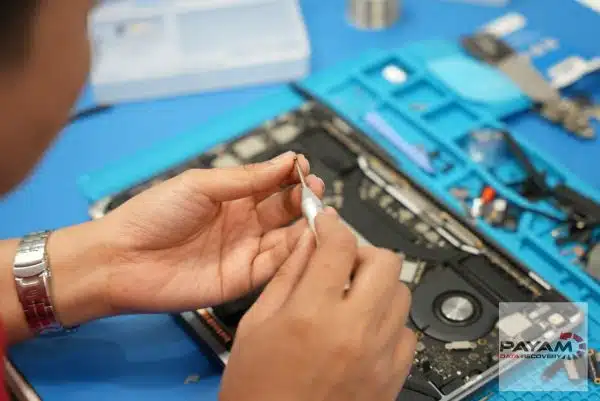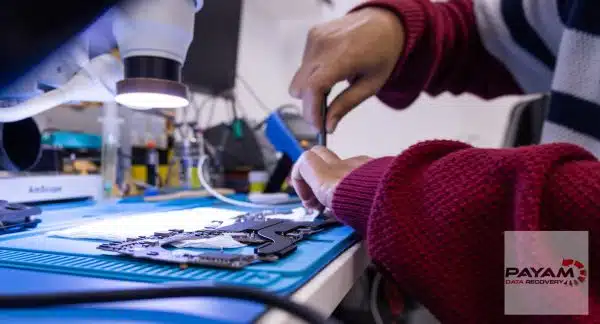MacBook Air M2 data recovery Australia is sometimes more complicated than it first appears. In this case study, you’ll discover how Payam Data Recovery solved a tricky case with a dead 2022 MacBook Air M2, highlighting the value of experience and careful diagnosis.
MacBook Air M2 Data Recovery Australia: The Case of the Dead MacBook Air M2
A client’s 2022 MacBook Air M2 arrived completely dead. When connected to a power supply, it drew unusually high current—an immediate sign of a short circuit on the motherboard. The technician removed the board and used a specialised infrared thermal camera to spot any components heating up under power.
Almost instantly, the thermal camera highlighted a MOSFET (a major power component) glowing brightly. This would usually indicate a failed part. But this case had a twist.
Glossary: What is a MOSFET?
A MOSFET (Metal-Oxide-Semiconductor Field-Effect Transistor) is a type of electronic switch found in almost all modern computers and digital devices. It has three main terminals—gate, drain, and source—and works by using voltage at the gate to control the flow of electricity between the source and drain. MOSFETs are essential for managing power and switching signals in a computer’s motherboard, and their ability to turn on and off quickly makes them ideal for both amplifying and switching electronic signals.
Experience Over Equipment
Despite what the equipment suggested, the technician’s experience told him to dig deeper. While most would have simply replaced the MOSFET, he suspected another culprit. Using freeze spray, he cooled a tiny capacitor next to the MOSFET, then injected voltage into the power line. The real problem revealed itself: the small capacitor was the actual cause of the short, not the MOSFET.
Replacing the tiny, inexpensive capacitor fixed the short circuit. The MOSFET was only heating up because it was next to the faulty capacitor—much like how a flat tyre, not the steering wheel, can make a car pull to one side.
The Fix and the Takeaway
Once the faulty capacitor was replaced, the MacBook Air powered on and worked perfectly. This case highlights why experience is so valuable in data recovery. Without it, a less skilled technician might have swapped the wrong part, wasted time and money, or even caused further damage.
After the hardware repair, another team member cloned and backed up all the client’s files to an external hard drive, ensuring their data was safe and accessible.
Key Takeaways
- Don’t always trust the first sign: The obvious fault isn’t always the real issue.
- Experience is key: Years of hands-on work provide insights that tools alone can’t offer.
- Small parts can cause big problems: Even a tiny, cheap component can bring down a whole system.
- Careful diagnosis prevents more damage: Rushing to replace parts without proper investigation can make things worse.
If you’re in a tough spot with a broken Apple MacBook and need your data back, learn more about our Apple MacBook Data Recovery Services or get a free data recovery quote today.
MacBook Models (2018–2025): SSD Types & Technical Specs
To help others understand what’s inside recent MacBooks, here’s a table of models, SSD types, and technical specs relevant to data recovery:
| Model & Year | SSD Type | Storage Options | SSD Interface | Typical Read/Write Speed | Notes |
|---|---|---|---|---|---|
| MacBook Air (2018) | PCIe NVMe | 128GB–1.5TB | PCIe 3.0 x2 | ~1300–1500MB/s | Removable SSD |
| MacBook Air (2020, Intel) | PCIe NVMe | 256GB–2TB | PCIe 3.0 x4 | ~2000–2200MB/s | Removable SSD |
| MacBook Air (2020, M1) | Soldered NVMe | 256GB–2TB | PCIe 3.0 x4 | ~2200–2900MB/s | SSD soldered to logic board |
| MacBook Air (2022, M2) | Soldered NVMe | 256GB–2TB | PCIe 3.0 x4 | ~2900–3200MB/s | SSD soldered to logic board |
| MacBook Air (2024–2025, M3/M4) | Soldered NVMe | 256GB–2TB | PCIe 4.0 x4 | ~3500MB/s+ | SSD soldered to logic board |
| MacBook Pro (2018–2019) | PCIe NVMe | 256GB–4TB | PCIe 3.0 x4 | ~2500–3200MB/s | Removable SSD (2018–2019) |
| MacBook Pro (2020, Intel & M1) | Soldered NVMe | 256GB–4TB | PCIe 3.0 x4 | ~2200–3200MB/s | SSD soldered to logic board |
| MacBook Pro (2021–2025, M1 Pro/Max/M2/M3/M4) | Soldered NVMe | 512GB–8TB | PCIe 4.0 x4 | ~3500–5500MB/s | SSD soldered to logic board |
Notes:
- Removable SSDs are common in older models, making recovery simpler.
- All Apple Silicon MacBooks (M1, M2, M3, M4) have SSDs soldered to the logic board, requiring advanced repair skills for data recovery.
- Newer models offer very high SSD speeds but are not user-replaceable.
Apple Data Recovery & Warranty Implications
It’s important to understand the warranty implications of data recovery. According to Apple’s official guidance:
- Products serviced by a data recovery company recommended by Apple can be returned to Apple for service.
- The cost of data recovery is not covered by Apple’s warranty or AppleCare plans.
- If a third-party company recommended by Apple modifies a product during data recovery, Apple will not exclude coverage solely on that basis.
- Devices damaged beyond normal usage (e.g. impact, liquid, etc.) are not eligible for warranty exchange, regardless of data recovery.
- Payam is listed among Apple’s recommended data recovery companies.
Use of third-party data recovery services is at your discretion. For full details, see Apple’s support page.
Table data compiled from Apple Support and official technical specifications for 2018–2025 models.



